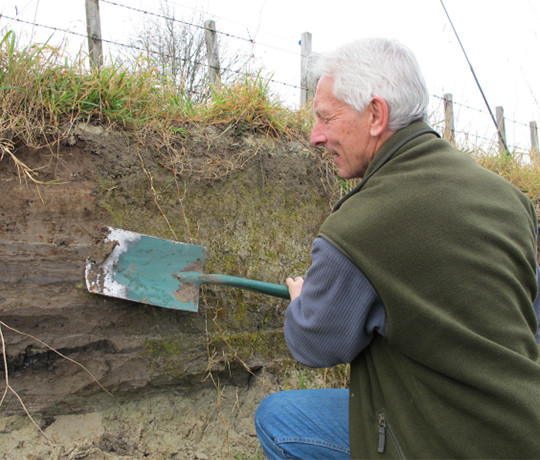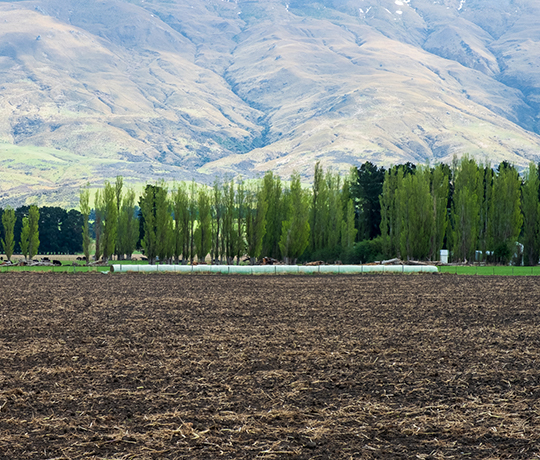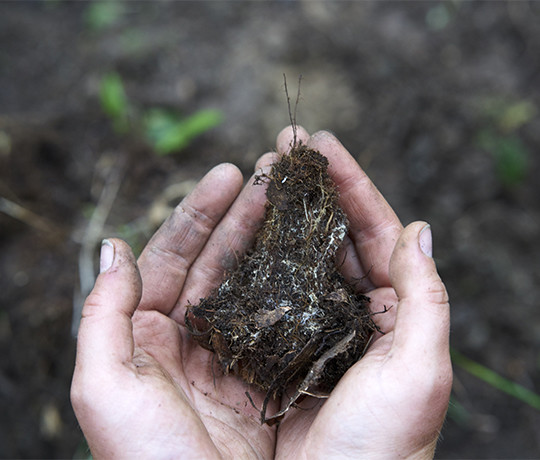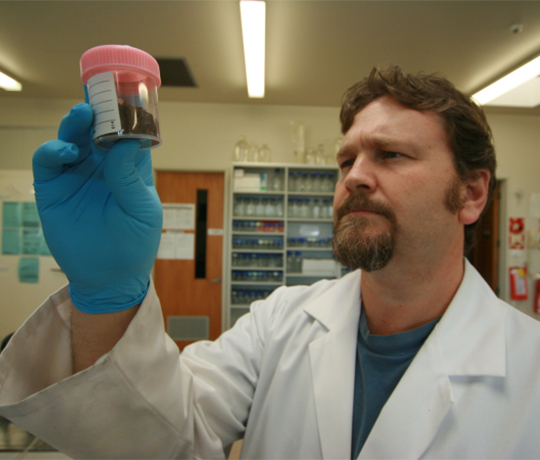Soil characteristics explained
Soils have many properties that we can measure to examine its state or 'health'
You can compare the soil to your body, and the soil scientist to a doctor who is trying to get information about your health when they measure your blood pressure or other characteristics of your body.
Three categories are commonly used to describe soil characteristics: Chemical, physical and biological properties.
Chemical properties broadly describe the fertility of a soil, the amount and availability of nutrients for plant growth. Chemical properties also include contaminants and toxic elements.
These are the most commonly measured chemical properties, and why they are important:
pH
The pH is a measure of how acidic the soil is. This is a very important soil characteristic, as the pH influences many chemical reactions and biological processes. Each chemical reaction and each soil organism has a favourite pH at which they perform best, and an upper and lower limit, where the reactions don’t work anymore, or the organism dies. Therefore, the pH can tell us a lot about the chemical reactions that are taking place, and the organisms that can live in a soil. The soil pH is usually measured in a mix of water and soil with a pH meter that measures the activity of hydrogen (H+) ions, as these ions create the acidity.
FAO has prepared an infograph to illustrate how pH influences the availability of nutrients in the soil and the health of the animals and plants that live in it.
Organic matter content
Organic matter is dead plant and (micro)organism material that is decomposed in the soil. The dark colour in topsoil, compost and potting mix stems from this organic matter. The decomposition of dead material is a way to recycle the nutrients: earthworms, fungi and bacteria and many other soil organisms eat the organic matter, and through their digestion the nutrients are released into the soil again. Organic matter is thus a measure of soil fertility. Organic matter content of a soil is commonly measured as total carbon, because organic matter consists mostly of carbon, and is usually the only source of carbon in NZ soils.
Phosphate retention
Phosphate is the chemical form of phosphorus that plants can take up. Phosphate retention is the amount of phosphate that a soil can adsorb onto particles. If phosphate is adsorbed a lot, it is not available for plants, but if it is not adsorbed, there is the risk of phosphate leaching away to the groundwater, where it is considered a contaminant. Phosphate retention is measured by adding a known amount of phosphate to a soil sample and analysing how much phosphate is still solution, and thus not adsorbed to the soil.
Cation exchange capacity (CEC)
Important plant nutrients calcium, magnesium and potassium have a positive chemical charge and are called cations. Cations will form chemically simple bounds to negatively charged clay particles and organic matter. Plants can access these nutrient cations. The amount negatively charged spaces available for cations to bind to is called the cation exchange capacity of a soil. If a lot of spaces are available for nutrient cations, this is a sign of a good fertility of the soil. The cation exchange capacity is measured by first removing all cations from the negatively charged sites of a soil sample, and then adding an “overdose” of cations to the sample, so that all exchange sites will be filled. Finally, the soil sample is again washed so that all cations leave the exchange sites, and we can measure how many cations were bound to the negatively charged exchange sites, and this gives us the number of exchange sites available.
The movement and storage of water and air in soil are physical properties, and also how easy it is to dig or work the soil.
These are the most commonly measured physical properties, and why they are important:
Texture
Texture refers to the sizes of the individual particles in a soil, excluding gravels and stones. Texture is traditionally measured by mixing a soil sample in water, after removing the gravels and stones by sieving, and measuring the time it takes for the particles of different sizes to settle. Sand particles are the largest and thus settle down in water first, followed by silt and clay.
Sand: particles with diameter between 0.06 and 2 mm; Silt: particles with diameter between 0.002 and 0.06 mm; Clay: particles with diameter smaller than 0.002 mm.
Texture classes are the dominant particle size of the mix of soil in your sample:
- Sand: less than 8% clay and less than 40% silt;
- Silt: less than 40% silt;
- Loam: more than 40% silt;
- Clay: more than 35% clay.
Structure
The structure of a soil describes how soil particles are clumped together in aggregates. If individual soil particles are not bound together at all there is no soil structure (single grains). Soil structure holds the soil together and creates air pockets for plant roots and organisms to breath. Structure is measured by taking a soil sample in your fingers and determining how easily it breaks. Alternatively, in a laboratory soil structure can be measured more precisely by applying force and measuring how much force is needed to break soil aggregates.
Colour
The colour of a soil tells us about how much organic material may be present in the soil by the darkness of the soil. Soil colour can also tell us what processes are going on in a soil, for instance water stagnation turns the soil greyish and with orange mottles, and relocation of organic matter or iron colours the soil at different depths. The colour of different soil horizons is described with a special colour book called the Munsell scale by comparing the moist soil colour to colours in the Munsell book.
Bulk density
The bulk density is the mass of dry soil in a specific volume. In soils without a lot of stones, we measure the bulk density by filling a container, usually a steel cylinder, with soil by pushing it into the soil. Then we dry the soil and weigh it to determine the mass, and we know the volume of the cylinder, so we can calculate the bulk density. In soils with a lot of stones it is too difficult to push a cylinder into the soil, so instead we excavate a small hole, take all the soil to the laboratory and dry and weigh it to obtain the mass, and we fill line the hole with a plastic bag and fill it with plastic beads, and we can calculate from the amount of beads that fill the hole what its volume is. Soils with low bulk density are fluffy and easy for roots and water to pass through, soils with high bulk density are heavy and often hard to dig or plough through.
Water-holding capacity
This describes how much water the soil can hold, like a sponge, and this is important for plants as it determines how much water is stored in the soil. The water-holding capacity is measured by saturating a soil sample in a container with water, and then letting the excess water drain, and measuring how much water stays in the soil. The water-holding capacity depends a lot on the texture of the soil, loose sand grains can’t hold a lot of water, and a dense clay soil will soak up a lot of water.
Hydraulic conductivity
How water flows through the soil is measured with the hydraulic conductivity. This can be measured by measuring how much water flows through a soil sample when a specific pressure is applied. The hydraulic conductivity of a soil depends on the pore sizes, which depends on the structure and texture of the soil. Larger soil particles create larger pores between the particles, and makes it easier for water to move through the soil. When the soil particles, even when they are small, lump together in aggregates, they form large pore spaces as well and this also makes the water move quickly.
Biological properties describe (micro)organisms living in the soil, who they are or how many are there, or how active they are and what they do.
These are the most commonly measured biological properties, and why they are important:
Earthworms
Earthworms are often used as a positive indicator of soil biological quality: earthworms decompose organic matter, making nutrients available for plants, and their channels allow air and water to enter the soil. Earthworms don’t like soil that is too hard for them to move through, and this usually means that other, smaller, organisms also won’t like that soil, so the earthworms are an indicator telling us whether a soil is a good living place for many soil organisms.
Mineralisable Nitrogen
Nitrogen is present in the soil as organic nitrogen, and this cannot be taken up by plants. Microorganisms can break down the organic nitrogen, and make it available for plants, and this process is called nitrogen mineralisation. We can measure how much nitrogen in the soil can potentially be mineralised and made available for plants, so this is a kind of stock of nitrogen in the bank for plants.
Microbial biomass
The soil is alive and full of microorganisms that we can’t see with the naked eye. To measure how many microorganisms are present, their biomass, we first analyse how much carbon we can extract from the soil while the microorganisms are active. We then inactivate the microorganisms by adding chloroform to the sample, and we measure the amount of extractable carbon again, the increase in carbon comes from the microorganisms, and by calculating the difference we know the biomass of microorganisms present in our sample.
This is a direct measurement of the microbial biomass, but we can also estimate the amount of microorganisms from their breathing (see “basal respiration”) or with DNA methods (see “microbial community composition”)
Basal Respiration
All the microorganisms in the soil as well as plant roots breath just like we do. Imagine measuring your own breathing, when you are breathing normally, as compared to while you are playing sports or running. We can also do this for soil microorganisms. The basal respiration is the normal breathing of microorganisms, and we can simply take a soil sample and measure the amount of CO2 that comes out of the sample over time, usually a day or so. We then know how much the microorganisms breath, and we can also estimate by their breathing how many they are. If we want, we can compare this normal breathing between different soils, or we can make the organisms work harder by giving them extra food or water, and see how they change their breathing. This tells us how active the microorganisms in the soil are.
Microbial community composition
With DNA analyses we can identify microorganisms in the soil that we can’t see with the naked eye. As such we can identify all the bacteria, fungi and other microorganisms that live in a specific soil, and this is called the community composition, similar to if you were to write down all the names of the people and animals that live in your neighbourhood. If you would also write all the jobs and skills that those in your neighbourhood have, you would get an idea of what your neighbourhood is capable of achieving. The same can be done for microbial communities in the soil, some species play very specific roles in the soil, and their presence in the soil can tell us what is going on with nutrient recycling or contaminant removal or pathogen attacks on plants. We can also roughly estimate how many microorganisms are in the soil by measuring how much DNA we find in the soil, although this is not very precise.






